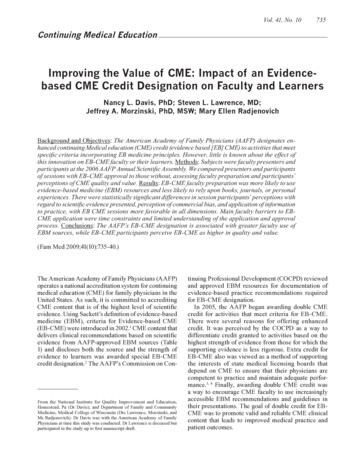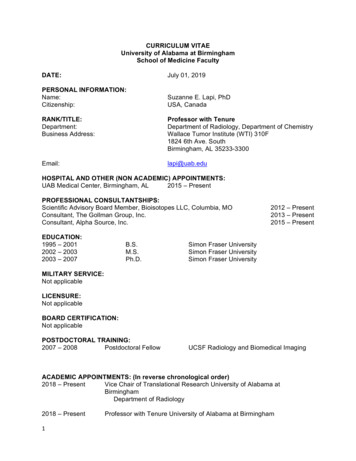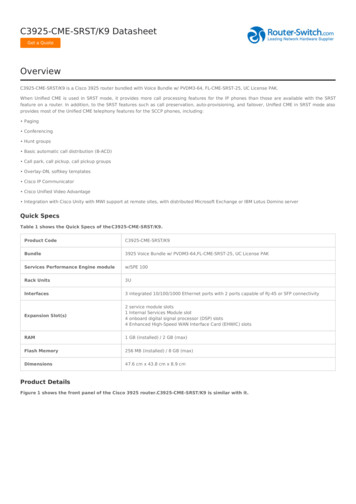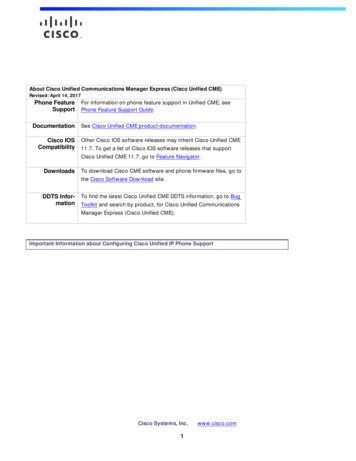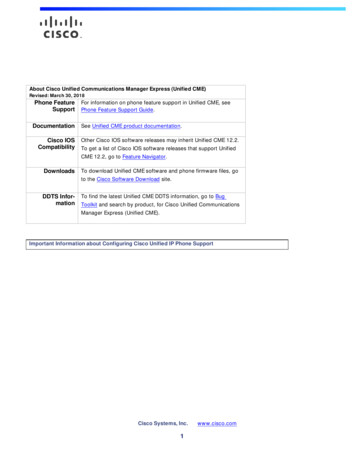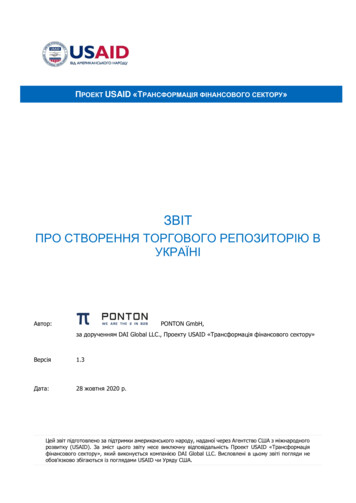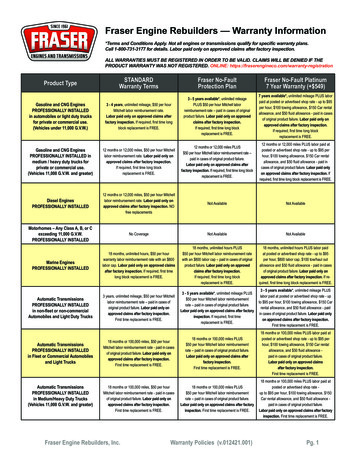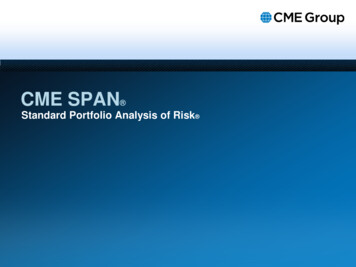
Transcription
CME SPAN Standard Portfolio Analysis of Risk
CME SPAN - Standard Portfolio Analysisof Risk Developed in 1988 by Chicago Mercantile Exchange Inc. to effectivelyassess risk on an overall portfolio basis. SPAN is a market simulation based Value At Risk system which hasbeen reviewed and approved by market regulators and participantsworld wide. SPAN is the official Performance Bond mechanism of 54 exchanges andclearing organizations world-wide, making it the global standard forportfolio margining. SPAN’s risk based margin requirements allows for effective margincoverage while preserving efficient use of capital. SPAN assesses risk for a wide variety of financial instruments including:futures, options, physicals, equities, or any combination. 2010 CME Group. All rights reserved2
CME SPAN - Objectives SPAN assesses the risk of a portfolio, by calculating the maximum likelyloss that could be suffered by the portfolio based on parameters set bythe margin-setting authority, usually an exchange or clearingorganization. The core of SPAN risk analysis is to simulate potential market movesand calculate the profit or loss on individual contracts given the marketmoves. Exchanges may determine any number of market scenarios to beincluded in the SPAN analysis. Most SPAN exchanges and clearing organizations use 16 scenarios. 2010 CME Group. All rights reserved3
CME SPAN - Methodology SPAN groups together financial instruments with the same underlying foranalysis. For example, Futures on an Equity Index and Options on the EquityIndex would be grouped together for analysis. Each product is referred to as a Combined Commodity. SPAN uses parameters set by the exchange or clearing organization toevaluate a portfolio with the following two step analysis: Step 1: SPAN first analyzes the risk of each Combined Commodityin isolation from other Combined Commodities. Step 2: SPAN then seeks risk reducing offsets between CombinedCommodities. 2010 CME Group. All rights reserved4
Scan Risk Arrays
CME SPAN - Scan Risk The core of SPAN risk analysis to simulate potential marketmoves and calculate the profit or loss on individual contracts. Exchanges or clearing organizations may determine any numberof market scenarios to be included in SPAN analysis. Most SPAN exchanges or clearing organizations use 16scenarios. The 16 scenarios are referred to as SPAN Risk Arrays. 2010 CME Group. All rights reserved6
CME SPAN - Scan Risk Arrays SPAN Risk Arrays represent a contract's hypothetical gain/loss under aspecific set of market conditions from a set point in time to a specificpoint in time in the future. Risk Arrays typically consist of 16 profit/loss scenarios for each contract. Each Risk Array scenario is comprised of a different market simulation,moving the underlying price up or down and/or moving volatility up ordown. The risk array representing the maximum likely loss becomes the ScanRisk for the portfolio. 2010 CME Group. All rights reserved7
CME SPAN - Scan Risk Example The next slide demonstrates the Scanning Risk calculation for anS&P500 portfolio: Long 1 Sep 2010 SP Futures (price is 1100) Short 1 Sep 2010 SP 1000 Call Option (implied volatility is 28%) The Price Scan Range is 22,500 or 90 points (CVF for SP500 is 250, 22,500/ 250 90points) The Volatility Scan Range for SP500 is 7% 2010 CME Group. All rights reserved8
CME SPAN - Scan Risk ExampleScenarioSP Underlying PriceMoveVolatility MoveSP FutureGain/LossSP 718072UNCHANGEDDOWN0-1,838-1,8383UP 33%UP-7,4997,8994004UP 33%DOWN-7,4995,061-2,4385DOWN 33%UP7,499-3,8363,6636DOWN 33%DOWN7,499-8,260-7617UP 67%UP-15,00114,360-6418UP 67%DOWN-15,00112,253-2,7489DOWN 67%UP15,001-8,9496,05210DOWN 67%DOWN15,001-13,9801,02111UP 100%UP-22,50021,107-1,39312UP 100%DOWN-22,50019,604-2,89613DOWN 100%UP22,500-13,4559,04514DOWN 100%DOWN22,500-18,7683,73215UP 300%UNCHANGED-22,27521,288-98716DOWN 300%UNCHANGED22,275-9,16013,115Largest Potential Loss SPAN Risk 2010 CME Group. All rights reserved13,1159
CME SPAN - Scan Risk Extreme Scenarios Deep out-of-the-money short options may pose significant risk, asunusually large price changes may result in unexpectedly large losses,particularly as expiration nears. SPAN accounts for this risk by including Extreme Scenarios in the RiskArrays. Extreme Scenarios may be used to simulate a significant market movedesigned to shock deep out-of-the-money options. Extreme Scenarios are determined by the Exchange or ClearingOrganization. CME uses a market move equal to 3 times the Price Scan Range for agiven product. The resulting gain or loss is then multiplied by apercentage of 33% to determine the potential exposure. 2010 CME Group. All rights reserved10
CME SPAN - Composite Delta Scenarios Composite Delta is derived as the weighted average of the deltas, wherethe weights are associated with each underlying price scan point. Below is an example of the 7 Delta Points used by CME:ScenarioUnderlying Price Change as % of PriceScan RangeProbability Weight1UNCHANGED0.273UP 33%0.2175DOWN 33%0.2177UP 67%0.119DOWN 67%0.1111UP 100%0.03713DOWN 100%0.037 2010 CME Group. All rights reserved11
SPAN AnalysisSpread Types & FormationsShort Option Minimum & Delivery Add-On ChargeNet Option Value
CME SPAN - Spread Types & Formation Intra-Commodity Spread : Evaluate the basis risk between contract periods withdifferent expirations within the same product. Spreads are prioritized by lowestcharge. Inter-Commodity Spread : Evaluate credit available for offsetting positions inrelated instruments. Spreads are prioritized by greatest total savings. SPAN forms Intra-Commodity Spreads before Inter-Commodity Spreads. Super Inter-Commodity Spread : Allows Inter-Commodity Spreads to beevaluated before Intra-Commodity Spreads. Inter-Exchange Spread Credit: Allows spreads to be formed for portfolioscontaining products listed on multiple Exchanges, as defined by the Exchange. The formation of Inter-Exchange Spreads is similar to process of formingInter-Commodity Spreads, however each Exchange can only provide a creditfor its own products. 2010 CME Group. All rights reserved13
CME SPAN - Intra-Commodity Spread Risk Since futures prices do not correlate exactly across contract months, a gain inone month may not exactly offset losses in another month. An Intra-Commodity Spread Charge can be set in SPAN to cover the risk ofcalendar spread positions. The Intra-Commodity Spread Charge can be tailored for contract pairs orspecified groups of contracts. There is no limit to the number of contract legs that can be specified in an Intra-Commodity Spread, also known as tiered intra-commodity spreading. The Intra-Commodity Spread Charge can also be tailored to specific calendarmonths. For example, a March versus September calendar spread can have a differentcharge rate than a March versus December calendar spread. This is also knownas series specific intra-commodity spreading. The next slide shows an example of an Intra-commodity Spread for a portfoliowith 1 long September 2010 and 1 short September 2010 Eurodollar. 2010 CME Group. All rights reserved14
CME SPAN - Intra-Commodity Spread Example The Intra-Commodity Spread Charge for Nov 2010 vs. Dec 2010 is 200. Since the gains on Nov ED exactly offset the losses on Dec ED, the Scan Risk is 0. Therefore, the Intra-Commodity Spread Charge of 200 becomes SPAN Risk.ScenarioSP Underlying PriceMoveVolatility MoveNov EDGain/LossDec NGEDDOWN0003UP 33%UP-25025004UP 33%DOWN-25025005DOWN 33%UP250-25006DOWN 33%DOWN250-25007UP 67%UP-50050008UP 67%DOWN-50050009DOWN 67%UP500-500010DOWN 67%DOWN500-500011UP 100%UP-750750012UP 100%DOWN-750750013DOWN 100%UP750-750014DOWN 100%DOWN750-750015UP 300%UNCHANGED-743743016DOWN 300%UNCHANGED743-7430 2010 CME Group. All rights reserved15
CME SPAN - Inter-Commodity Spread Risk To recognize the risk reducing aspects of portfolios containing off-settingpositions in highly correlated instruments, SPAN forms Inter-CommoditySpreads. Inter-Commodity Spreads produce credits which reduce the overallperformance bond or margin requirement. The universe of recognized spreads, rates, and priority are determinedby the Exchange. Below is an example of 1 Long SP future and 2 Short Nasdaq futures.The recognized spread ratio is 1 SP vs. 2 ND and the spread credit is85%.CombinedCommodityPositionOutright PBRequirementSPLong 1 22,500NPShort 2 14,000 x 2 28,000Total 2010 CME Group. All rights reserved 50,500Recognize SpreadCreditSPAN RequirementX 85% 42,925 7,57516
CME SPAN - Inter-Commodity Delta BasedSpreading Delta Based Spreading is performed after the Scan Risk or Scanningprocess. One result of the Scanning process for each Combined Commodity is aNet Delta position, which is an estimate of market exposure that has notbeen offset within the Combined Commodity which is available to beoffset between Combined Commodities. Each exchange defines a table of recognized Inter-Commodity Spreadformations and the margin credit to apply for such formations. SPAN takes the Inter-commodity spread table and seeks out the definedspread formations, giving margin credit for each spread formed. A Delta based spread may contain any number of spread legs. 2010 CME Group. All rights reserved17
CME SPAN - Inter-Commodity ScanningBased Spreading Another method of recognizing offsetting positions between CombinedCommodities is Scanning Based Spreading. Scanning Based Spreading recognizes risk offsets among CombinedCommodities by scanning them together. Scanning Based Spreading allows for the recognition of risk reductiondue to correlated underlying price moves and also the risk reduction dueto offsetting option positions. In recognizing that the correlations between Combined Commoditiesmay not be perfect, the gains in the Scanning process may be limited bya gain allowance factor set by the exchange. The next two slides show an example of the potential benefits achievedthrough Scanning Based Spreading as opposed to Delta BasedSpreading. Both slides use the same position of: Long 90 Bond futures Short 90 10yr futures 2010 CME Group. All rights reserved18
CME SPAN - Delta Based Spread Example Long 90 Bond futures & Short 90 10yr futuresSpread PositionsSpread CreditRemaining DeltaDelta-Based TotalRequirementProductPositionOutright PBRequirementSpread RatioBond90 2,500210 yr-90 1,4003ProductPositionOutright PBRequirementPosition x OutrightPBBond60 2,500 150,00010 yr90 1,400 126,000ProductPositionOutright PBRequirementPosition x OutrightPBBond30 2,500 75,00010 yr0 0 0Remaining DeltaPB RequirementSpread Req.(30%)Total PBRequirement 75,000 82,800 157,800 2010 CME Group. All rights reservedSpread Credit70%Spread Credit 276,000 x .7 193,20019
CME SPAN - Scanning Based Spread Example Long 90 Bond futures & Short 90 10yr futuresScenarioUnderlying Price MoveVolatility ChangeGain/Loss1UNCHANGEDUP 02UNCHANGEDDOWN 03UP 33%UP- 10,4494UP 33%DOWN- 10,4495DOWN 33%UP 45,5496DOWN 33%DOWN 45,5497UP 67%UP- 21,0518UP 67%DOWN- 21,0519DOWN 67%UP 91,25110DOWN 67%DOWN 91,25111UP 100%UP- 31,50012UP 100%DOWN- 31,50013DOWN 100%UP 136,80014DOWN 100%DOWN 136,80015UP 300%UNCHANGED- 31,18516DOWN 300%UNCHANGED 135,432Scanning Based PB Requirement 2010 CME Group. All rights reserved 136,80020
CME SPAN - Short Option Minimum Deep out-of-the-money short options may show zero or minimal ScanRisk given the price & volatility moves in the 16 market scenarios. However, in extreme events these options may move closer to-the-money or in-the-money, thereby generating potentially large losses. To account for this potential exposure, a Short Option Minimum can beset for each product. If the Scan Risk is lower than the Short Option Minimum, then the ShortOption Minimum is charged. The next slide shows an example of the Short Option Minimum using adeep out-of-the-money short put. Short 1 SP500 Sep 2010 Put @500 (underlying price is 1100) Short Option Minimum on 1 SP500 is 225 2010 CME Group. All rights reserved21
CME SPAN - Short Option Minimum Example Scan Risk is 88, however SOM is 225, so the requirement is 225.ScenarioUnderlying Price MoveVolatility ChangeGain/Loss1UNCHANGEDUP2UNCHANGEDDOWN3UP 33%UP4UP 33%DOWN5DOWN 33%UP 276DOWN 33%DOWN- 97UP 67%UP8UP 67%DOWN9DOWN 67%UP 4110DOWN 67%DOWN- 711UP 100%UP- 112UP 100%DOWN13DOWN 100%UP 6214DOWN 100%DOWN- 415UP 300%UNCHANGED- 416DOWN 300%UNCHANGED 88 16- 10 8- 10 3- 11- 11Scan Risk 2010 CME Group. All rights reserved 8822
CME SPAN - Summary of SPAN Analysis Scan Risk: Evaluate the directional market risk. Intra-Commodity Spread Charge: Evaluate the basis risk between contractperiods with different expirations within the same product. Inter-Commodity Spread Credit: Evaluate credit available for offsettingpositions in related instruments. Delivery Add-On Charge: Evaluate contract periods for increasing volatilityduring delivery. Short Option Minimum: Evaluate short option positions for potential increasedrisk, using the greater of the Scan Risk or Short Option Minimum. SPAN Requirement for a Combined Commodity is the greater of: (Scan Risk Intra Commodity Spread Charge Delivery Charge – InterCommodity Spread Credit) Short Option Minimum The Total SPAN Requirement for a portfolio is the sum of the SPAN Requirementfor all Combined Commodities. 2010 CME Group. All rights reserved23
CME SPAN - Net Option Value Mark-to-market of options is reflected in the Net Option Valuecomponent of SPAN. The Total Performance Bond Requirement for a portfolio reflects theTotal SPAN Requirement and the Net Option Value of the portfolio. The Net Option Value (NOV) of a portfolio is equal to the Long OptionValue minus the Short Option Value. Long Option Value (LOV): The total value of all the long options in theportfolio. Short Option Value (SOV): The total value of all the short options in theportfolio. LOV reduces the overall Total Performance Bond Requirement. SOV increases the overall Total Performance Bond Requirement. 2010 CME Group. All rights reserved24
CME SPAN - Net Short Option Value The portfolio below includes: Long 1 Sep 2010 SP Futures (price is 1100) Short 1 Sep 2010 SP 1000 Call Option (price is 119.10, value is 28,150) Long 1 Sep 2010 SP 900 Put Option (price is 3.20, option value is 162.50)SPAN Risk 7,132LOV 162.50SOV 28,150NOV ( 27,987.50)Total Requirement SPAN Risk NOV 7,132 - ( 27,987.50) 35,119.50 2010 CME Group. All rights reserved25
CME SPAN - Net Long Option Value The portfolio below includes: Short 1 Sep 2010 SP Futures (price is 1100) Long 1 Sep 2010 SP 1000 Call Option (price is 119.50, value is 28,150) Short 1 Sep 2010 SP 900 Put Option (price is 3.20, option value is 162.50)SPAN Risk 585LOV 28,150SOV 162.50NOV 27,987.50Total Requirement SPAN Risk NOV 585 - 27,987.50 ( 27,402.50) 2010 CME Group. All rights reserved26
Developed in 1988 by Chicago Mercantile Exchange Inc. to effectively assess risk on an overall portfolio basis. SPAN is a market simulation based Value At Risk system which has been reviewed and approved by market regulators and participants world wide. SPAN is the official Performance Bond mechanism of 54 exchanges and


